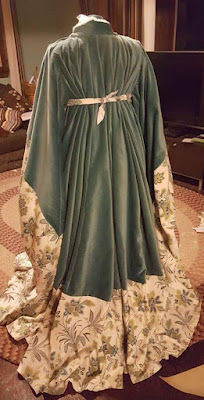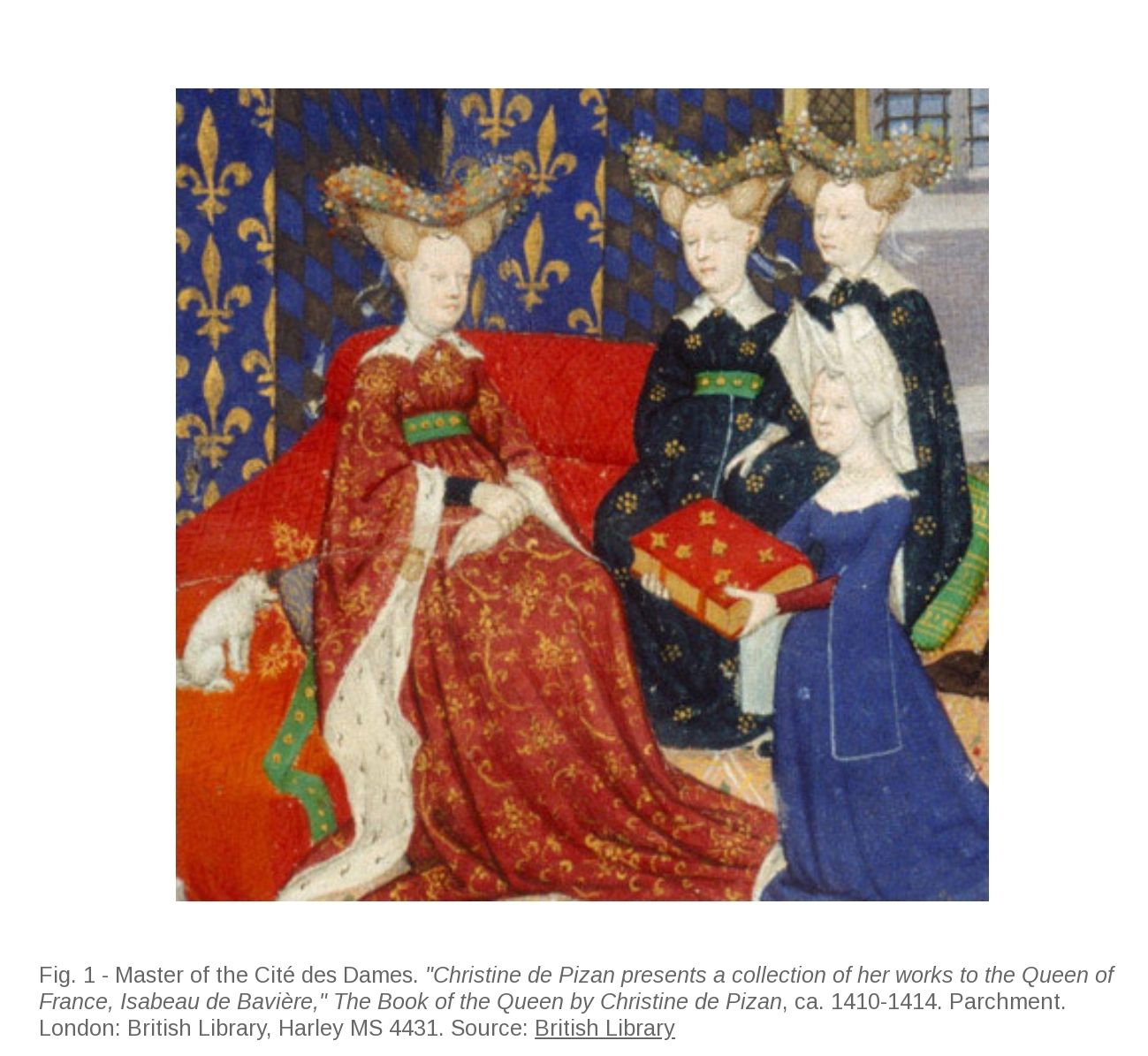Pages
Sunday, 31 December 2023
The Woes of Bag Lining.
Sunday, 24 December 2023
Planning a houppelande, the details! Embroidery musings and Linings.
I've chosen this piece for my inspiration. I wanted something that was Gold work, clearly French, not overly religious and early 15th century, ignoring the figures, it is also something simple enough and can easily be done within my current skill level, resources and time frame.
Thursday, 21 December 2023
Planning a new Houppelande, learning from the Past.
This is a long term Project that is still in the planning and gather phase, but I wanted to gather all my info in one place, and figured it might be helpful to other folks.
My first one is here on my old blog.
The original extant piece that this pattern clearly is representing. I might do a bit of embroidery to push my fabric closer to this period example.
This is a green and gold silk produced in Venice Italy in the beginning of the 15th century, which has a very similar vine and floral pattern, that could have easily made it's way into France through the Italian trade guilds. Venice was also known for it's silk velvet production.
Friday, 1 December 2023
The Flow Of Silk
The Roman Empire was pivotal in connecting the world, it founded trade routes from all corners of the Known world. Allowing for a steady flow of luxury goods, silks, spices, and knowledge to flow into western Europe. With the fall of Rome, much of that was lost, plunging western Europe into isolation. However Byzantine, the Levant, India, and eastern Asian cultures thrived, trade and preservation and building of knowledge continued. We find dye resist fabrics produced in India in both western Asia and Egypt in large quantities.
With the spread of Islam, a lot of this knowledge became more accessible to Western Europe. The Crusades organized by the catholic church seem to have a side effect, of exposing the goods and knowledge Western Europe was lacking. Which Knights then brought home, and showed their peers. Creating a larger demand for luxury foreign goods.
Before the 13th century silk was rare, affordable only by the select nobility and the church. Extant examples of silk are small, such as trims, embroidered pieces, or that of the church or royalty. Most of which was made and imported from Iran, Byzantine, Mongolia and eastern Asia through the silk road. Often called Tartar cloths.
Silk production was established in Italy in Lucca in the 12th century. which was a highly guarded secret which allowed for a monopoly to flourish.
In the East, the Islamic Mongol conquest of the 13th century created trade opportunities. Trade routes in the Mediterranean thrived. Silk production was expanded in Spain, North Africa, Southern Italy, and the middle east. The sultanates encouraged the production of silks and trade, often inviting Italians merchants.
The Reconconisita of Spain also meant that Spanish Silk workshops were now under control of Christian rule and enveloped into Northern Europe trade.
Also durring the 13th century, due to Mariage alliances between French, Spanish and Italian royal households encouraged and the flow of Immigrants from silk producing regions to Paris, which became the center for foreign luxury goods in North western Europe.
Addtionally, at this time a small industry of smaller silk goods began to be produced in Paris and other North Italian cities. By the end of the 13th century these places were able to produce small amounts garment quality silk. This was in addition to the large influx of foreign silk from Lucca and the east brought by the Italian merchants.
The shake up in the economy after the Plague meant that skilled workers were less readily available and wages were higher. People also had more money after the plague, creating a higher demand for luxury goods. Since silk had less intensive labour costs, and luxury prices, it was a very lucrative market.
Lucca had political strife and the guild system that tended margainalize silk workers, so highly skilled weavers were enticed with tax breaks and social incentives to other areas of Italy, Genoa, Milan, Venice, and Paris, creating competition, and so Italy, and Paris became flush with European produced silks.
The French and English inventories I study show a steady increase in silk garments throughout the 14th century. By the end of the fourteenth century most prosperous folks had at least one garment made of silk.
This competition, along with the nobility's desire to set themselves apart, encouraged more variety and complexity. So started to break from the traditional roundels with animal figures to produce wild patterns, Arabic influences, tartar patterns, shot silk, velvets and in the early 15th century Florence, goldsmiths were employed to create cloth of gold.
To Protect the concept of nobility, Italy’s sumptuary laws stated that certain classes could only wear black silk, because black silk was a much more expensive dye process, making it out of the reach for most folks. But instead of curbing silk, It created a huge demand for black silk production, And people who travelled to Italy saw this sea of black and copied it, so that by 1400 Black silk became the in vogue colour to wear in Northern Europe.
Further Reading-
Maria Ludovica Rosati
A Workshop Larger than a City: The Florentine Textile Manufacture, in Textiles and Wealth in 14th Century Florence. Wool, Silk, Painting, Exhibition Catalogue (Florence, 5 December 2017-18 March 2018), ed. by C. Hollberg, Florence, Giunti, 2017, pp. 64-73
Wool in 14th Century Florence: The Affirmation of an Important Luxury Production, in Textiles and Wealth in 14th Century Florence. Wool, Silk, Painting, Exhibition catalogue (Florence, 5 December 2017-18 March 2018), ed. by C. Hollberg, Florence, Giunti, 2017, pp. 42-51
The development of the Florentine silk industry: a positive response to the crisis of the fourteenth century, Sergio Tognetti 2005, Journal of Medieval History
Dressing the King and the Beggar: The Various Levels of the Textile Market and their Prices in Medieval Valencia (13th - 15th centuries), Juan Vicente García Marsilla
Ertl, Thomas, and Barbara Karl. Inventories of textiles - textiles in inventories: Studies on Late medieval and early modern material culture. V & R unipress, Vienna University Press, 2017.
Farmer, Sharon A. The Silk Industries of Medieval Paris: Artisanal migration, technological innovation, and gendered experience. Philadelphia: University of Pennsylvania Press, 2017.
Ferrand, Guilhem, and Jean-Pierre Garcia. Les inventaires après décès de la Ville de Dijon À la fin du moyen age: 1390-1459. Toulouse: Presses universitaires du Midi, 2017.
Monnas, Lisa. Merchants, princes and painters: Silk fabrics in Italian and northern paintings, 1300-1550. New Haven Conn.: Yale University Press, 2008.
Monnas, Lisa. Renaissance velvets. London: V & A Publishing, 2012.
Newton, Stella Mary. Fashion in the age of the black prince a study of the years ; 1340 - 1365. Woodbridge: Boydell Pr, 1980.
Snyder., Désirée G. Koslin, Janet E. Encountering medieval textiles and dress. Palgrave Macmillan US, 2002.
The Right to Dress Sumptuary Laws in a Global Perspective, c. 1200– 1800 Edited by Giorgio Riello Ulinka Rublack: University of Cambridge, 2019
Wednesday, 25 October 2023
Some sources for extant fabrics
One of the things that I am learning though this fixation is that textiles were a lot more moveable than I previously imagined. I'm seeing many fabrics made in India that are in Egypt. A lot of textiles with Arabic on them associated with Italy or Prague even. Also my perceptions of what I thought were clear stylistic divisions in culture and time period are not as compartmentalized as I thought.
Tuesday, 17 October 2023
Queen Anna Burial Fabric (Lucca Italy 1350)
I found this sketch of a 14th century Fabric on Pinterest. with the caption


































.jpg)


.jpg)








